Halfway through the second decade of the millennium, it seems it’s time to take stock of the international state of the horror union. Today two websites, seemingly independently, released their lists of the best horror films of the past fifteen years. Here’s where you can read the list at Film School Rejects and here’s the one at The A.V. Club. Both lists are excellent, full of films worth recommending. That to me is the value of these kinds of lists, more than arguing over which movie shouldn’t be there or which one ranks higher than the other. I like the idea of reading lists by smart people with the purpose of searching out new-to-me movies I might like. So this is not going to be a hip-hop-style answer track. There’s no quibble to be made. (In fact, contributors at both venues are contributors here! Friendship!)
It’s clear there’s a consensus forming, in that some films made both lists and have made other such lists in the recent past and would be on my list too if others hadn’t mentioned them already. THE DESCENT, I’m happy to see, ranks near the top every time the question comes up. LET THE RIGHT ONE IN is a given. MULHOLLAND DR., UNDER THE SKIN, and THE HOST, as much as they count as horror, are solid contenders. In any conversation about superlative horror over the past decade and change, I’d also be sure to consider AMERICAN MARY, the [REC] series, 28 DAYS LATER and its sequel, THE INNKEEPERS, WENDIGO, SINISTER, THE WOMAN, THE LOVED ONES, I SAW THE DEVIL,STAKE LAND, TRIANGLE, and SPRING. There are no doubt others.
But naturally, there’s stuff I didn’t see on either list so I can’t resist providing my own alternative. A couple of my choices may have been name-checked but not featured; others didn’t show at all, so here’s their time to shine.
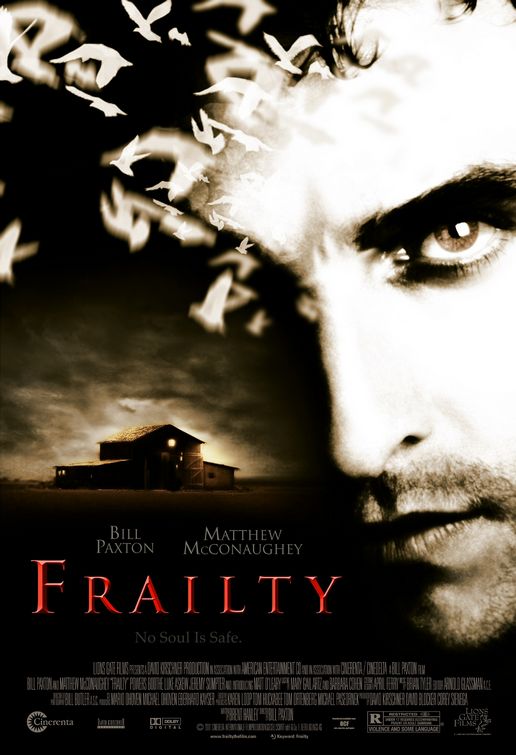
FRAILTY (2001)
This film has an intriguing symmetry with John Sayles’ 1996 drama LONE STAR, in that both feature Matthew McConaughey in stories of men reckoning with the dark legacies of their fathers. Here the father is played by Bill Paxton, who also directed. I have friends who dismiss Paxton (and the actor with whom he’s often confused, Bill Pullman) as bland — which is one way of saying I have friends who sometimes talk out their asses. Bill Paxton is a mischievously deceptive talent, able to play nobly-carved heroes if that’s what the job entails, but more at home playing yahoos and madmen. His first film as director found him square in the latter wheelhouse as both filmmaker and actor, and it’s an excellently nasty piece of business.
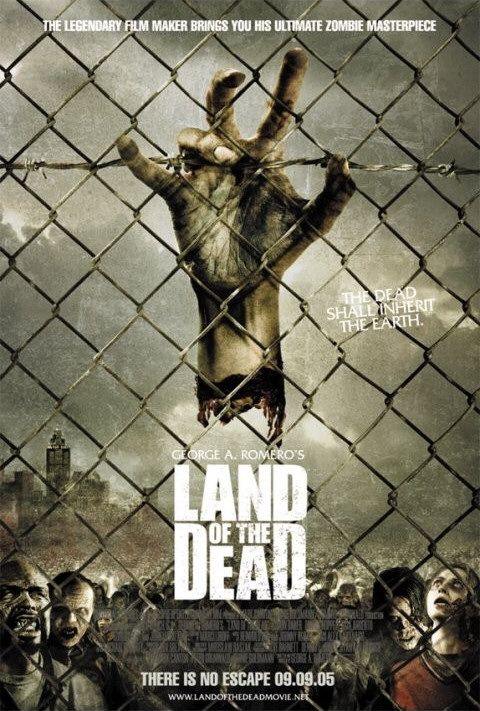
LAND OF THE DEAD (2005)
One beautiful aspect of this film, a return to a genre by its undisputed champion, is how it has the sense of scope that George A. Romero’s earlier zombie trilogy only hinted at. NIGHT OF THE LIVING DEAD doesn’t go much further than cemeteries and farmhouses. DAWN OF THE DEAD opens up that world quite a bit, beginning as it does inside a TV station and heading to tenement buildings before a helicopter ride reduces the scale and strands its characters inside that notorious shopping mall. Set inside a subterranean research installation, DAY OF THE DEAD is the most claustrophobic of them all — intentionally so. But LAND OF THE DEAD takes pains to show how the outbreak of the undead has irrevocably changed the face of civilization. It’s nearly more of a post-apocalypse movie than a horror movie, as much THUNDERDOME as it is DAY OF THE DEAD. It also is notable for featuring one of the few great black horror villains or anti-heroes (horror cinema has several great black heroes, but very few villains) in Eugene Clark’s Big Daddy, and it arguably has Dennis Hopper’s last great screen appearance. One could argue that LAND OF THE DEAD is not a movie that stands with the absolute best work of either artist, but it’s hilarious, knowing, and fun, especially coming from a diehard progressive like Romero. By this time in his life, counter-culture icon Hopper had somewhat ironically become an arch-Republican, but he was still rebel enough to lampoon the greedy war profiteers who were running that party at the time. It’s a good bet that George Bush Jr., Dick Cheney, and Karl Rove never saw LAND OF THE DEAD, but if they had, it’s nice to think of them wincing with recognition. (Too bad people like that don’t have half the self-awareness of a guy like Dennis Hopper.)

BEHIND THE MASK: THE RISE OF LESLIE VERNON (2006)
A faux-documentary that pre-supposes all the names up there on the poster really exist, BEHIND THE MASK is a killer concept that runs for a good long while before it loses its head. Jason Voorhees took on Freddy Krueger just three or four years before this movie saw the light of day, so it’s not too hard to accept the premise that there’s some alternative movie-world where wannabes aspire to be monstrous psycho-killers. Still better that than “Vine celebrity,” right? BEHIND THE MASK has a fun joke already in the title, since the gender-neutral name Leslie doesn’t quite so quickly lend itself to horror ubiquity as do the names Jason or Freddy. It doesn’t sound particularly wrong, but nor does it sound right. For a while, BEHIND THE MASK compares favorably to the pivotal 1992 faux-documentary MAN BITES DOG, wherein ambitious and foolhardy journalists tailed a serial killer with their cameras before ultimately becoming a part of his story. The same thing happens here, and the twisted fun of BEHIND THE MASK is in how we see the disarmingly energetic and upbeat Leslie (a very good and almost Carrey-esque Nathan Baesel) go about the business of preparing to become a silent, unstoppable mass-murderer. But every horror bad guy has his fatal flaw, and BEHIND THE MASK‘s is that its inevitable shift is difficult to buy into — we know Leslie too well by the time he puts on the mask and begins his rampage, so we may root for him to be stopped, but we don’t exactly fear him the way we might fear Jason, or Michael Myers. Those guys were scary precisely because of their inability to be known. You couldn’t talk to them, and you couldn’t stop them. In the end, Leslie Vernon can’t make the big leagues. Then again, that sort of works in the movie’s favor, in an odd way.

HELLBOY 2: THE GOLDEN ARMY (2008)
With respect to the many things there are to like about PACIFIC RIM, here is the best blend to date of director Guillermo Del Toro’s arthouse instincts and crowd-pleasing desires. Clive Barker infamously described his film NIGHTBREED as an attempt to create a “STAR WARS of horror.” That’s what Del Toro accomplished with HELLBOY 2.
HELLBOY The First (from 2004) was a solid enough cinematic interpretation of a pretty damn esoteric piece of work, and a minor miracle in the fact that it was made alone, but some of the quirk and the spark of both comic creator Mike Mignola and Del Toro’s best work went missing. A couple of intriguing villains drove the story, but a lot more screen time was dedicated to Hellboy fighting a reptile-type demon character that felt a little too derivative. Also, there was an audience point-of-view character who redefined blandness – again, who cares about the humans when there’s a big red demon guy running around with his best friend, an amphibious blue guy named Abe Sapien?
HELLBOY 2 fixes all that. I especially like the simple brushstroke by which the moviemakers explain what became of that boring white guy from the first movie. It has humor and pathos and even a little suspense, thanks to the script and choices made by Del Toro, the performances of a solid cast, characteristically striking cinematography by Guillermo Navarro, and a solid score by Danny Elfman.
And the movie is full of monsters. I love movie monsters. I love them so much. I love King Kong, and Godzilla, and the Wolf Man, and the Predator, and those skeletons from JASON & THE ARGONAUTS, and the Terminator, and Gamera, and Mighty Joe Young, and the Creature From The Black Lagoon, and Nick Nolte, and all the other freaks and creatures that live forever on film. All I ever want from a monster movie is that it introduces me to sights I’ve never seen before, beings I’ve never met and never will. HELLBOY 2 does that over and over. It introduces more a few new faces that we’ve never seen before. The Golden Army referred to in the title is just so unbelievably joyful to watch, when they finally show up in the final act. And the way that Hellboy & Friends confront them is equally enjoyable. And there’s a fella named “Wink” in this film who absolutely does not have a name to fit his face. He’s amazing. The movie misses him when he leaves it. Hell, all movies have, ever since.
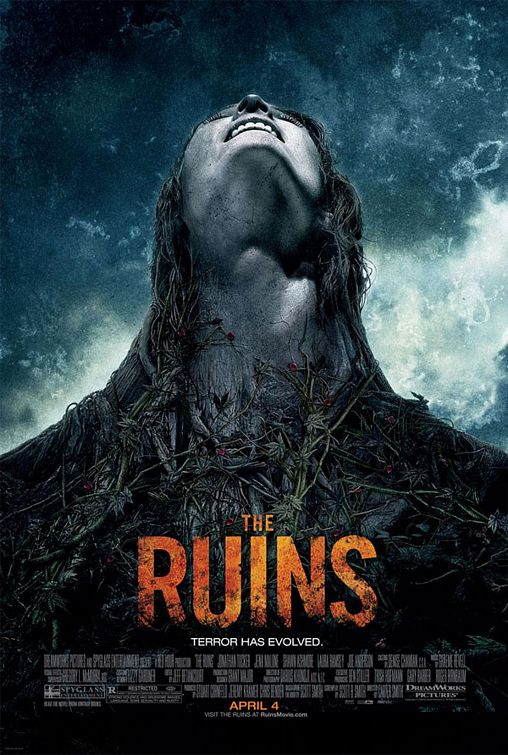
THE RUINS (2008)
The source material for THE RUINS is a creepy, suspenseful, un-put-down-able novel by Scott Smith, who also wrote A SIMPLE PLAN, which is also a mighty underrated thriller in its own right. Basically, THE RUINS is about evil vines. We’ve seen scores upon scores of villains from nature, but the lion’s share of them are fauna, not flora. There aren’t a lot of villainous plants out there. Off the top of my head, there’s LITTLE SHOP OF HORRORS, ATTACK OF THE KILLER TOMATOES, andTHE HAPPENING, but all of those are comedies. THE RUINS is the rare legitimately-spooky horror movie where vegetation is the main source of scares. The film follows a solid cast of young people – Jena Malone, Shawn Ashmore, Jonathan Tucker, Joe Anderson, and the painfully cute Laura Ramsey – as they take a trip down to Mexico and enter some remote Mayan ruins which turn out to be no place for gringos. Director Carter Smith (no relation to the book’s author) maintains a strong sense of creeping terror, but the real star of the show is master cinematographer Darius Khondji, probably most famous for SE7EN, who knows exactly how to deploy shadows and light for maximum impact.
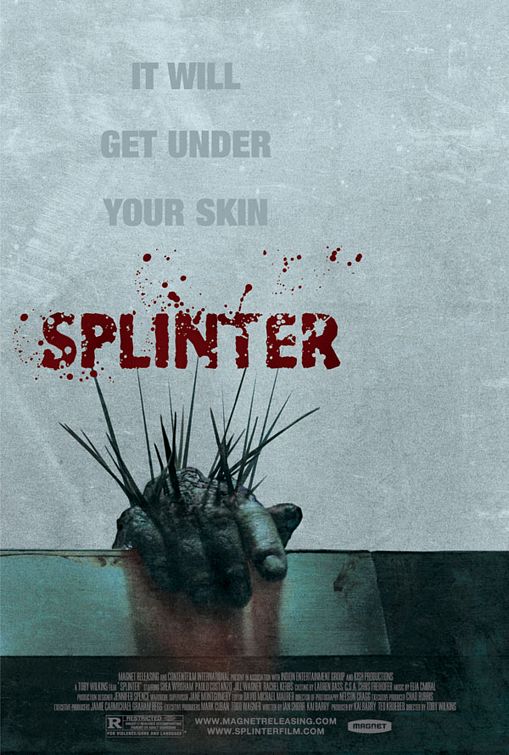
SPLINTER (2008)
Hey, remember that scene in THE THING where Kurt Russell has to slice the finger of each of his coworkers for a blood test in order to determine which one of them is The Thing? Remember that scene in EVIL DEAD 2 where Bruce Campbell has to lop off his own hand and then the evil possessed hand returns to torment the rest of him? Do you like horror in its squeamiest of varieties? Then this is a movie for you.
Ably directed and co-written by VFX veteran Toby Wilkins, SPLINTER is admirably simple and efficient. After their camping trip ends prematurely due to a malfunctioning tent, a young couple (Jill Wagner and Paolo Costanzo) hits the road to find a motel. They’re hijacked by a criminal and his cracked-out girlfriend. So that outlaw couple takes the civilian couple hostage – we’re in a crime movie, okay? — then all of a sudden the car rolls over a dog. Or a porcupine. Or something. Whatever it is, it’s angry. The human beings head to a gas station to regroup, only to find that something – a ‘something’ related to the ‘something’ they ran over – has invaded the area. Bad, ugly things proceed to happen, most often to human extremities.
This movie is fun because the suspense works. The characters have to quickly think and act their way through a series of set-pieces as they are besieged by an undefinable creature, and though I’ve seen this kind of set-up so many times before, I still couldn’t say for sure how it’d end up until it finally ended. Energy is also provided by the tremendous character actor SheaWhigham in the role of the outlaw. He brings an entertaining,wackadoo, bizarro Bill Pullman kind of energy to the role. You may have since seen him in Boardwalk Empire, TAKE SHELTER, SAVAGES, MACHETE, FAST & FURIOUS 6, and BAD LIEUTENANT: PORT OF CALL NEW ORLEANS.
Whigham’s eccentric badassitude is well-matched by the movie’s creature concept, which is awesome and original, the latter adjective being especially rare in horror movies. I don’t want to reveal a thing, except that the monster is a good idea, one that I don’t remember seeing on film before, and I wanted to see more of it. The creature is creepy, gross, and believably lethal – what more could a movie like this need?
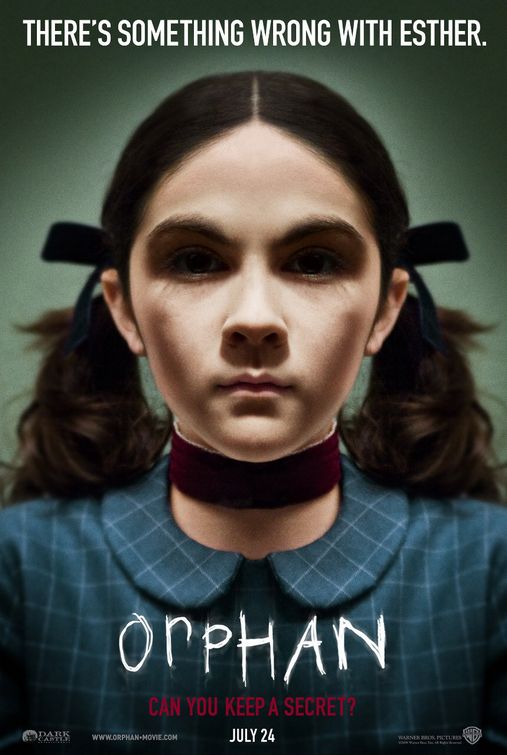
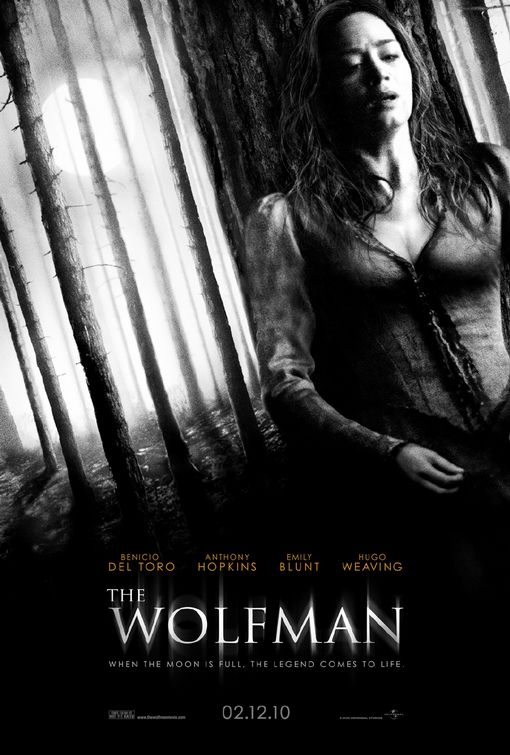
Disproportionately reviled, 2010’s update of THE WOLFMAN is admittedly no classic and it’s certainly no revolution, but it has teeth and fur and blood and corsets and torches and castles and fog and forests, and that’s plenty of what’s fun about movies as far as I’m concerned.
There are several elements you need if you’re re-envisioning the classic WOLFMAN…
You need a pained protagonist.
You need a pretty girl to get him all riled up.
You need a creepy old gypsy woman.
You need the makeup.
You need daddy issues.
You need an ending less than happy.
The new WOLFMAN, then, isn’t so far removed from the original as you might think. It’s interesting to look at the two side-by-side and notice how Curt Siodmak’s original story for the 1941WOLFMAN was absolutely the blueprint for the new story. When I saw 2010’s WOLFMAN, I was surprised to see how closely the set-up mirrored the classic tale. Just as in the original, Larry Talbot is Americanized and way taller and incongruously related to his very British father, Sir John. (Benicio Del Toro looms over Anthony Hopkins just as Lon Chaney Jr. loomed over Claude Rains, and neither pair looks any more related to each other than I do to Yao Ming.) As in the original, Larry is brought back to Talbot Manor by his brother’s death. Gwen Conliff[e] isn’t his sister-in-law-to-be in the old movie, but she does run a home furnishings store. Somewhat creepily (though innocently), Larry spies on Gwen with his father’s telescope in the 1941 WOLFMAN – in the new version, the telescope is also a noticeable element: Sir John uses the telescope as a means to babble away about the moon to his son. The wolf cane is an essential prop – in the new movie, it’s a Talbot family heirloom, though in the original, Larry bought it from Gwen’s store. I could go on about all of these fidelities, but I won’t. The point to be made is that the new movie was made with great respect towards the old one.
There are changes and updates too, of course. Some are necessary, some are interesting, some work, some maybe don’t. The script credited to Andrew Kevin Walker (SE7EN, SLEEPY HOLLOW) and David Self (ROAD TO PERDITION) makes one monumental change, in particular, which has to do with the aforementioned daddy issues, and gives Anthony Hopkins sharper teeth with which to gnaw away at the scenery. Let’s just leave it at that, without spoiling much further, but note that this development dramatically alters the climax of this particular WOLFMANstory – for the worse, if you read the majority of the reviews. As for myself, I found it a worthy experiment at the very least, and in fact I think I liked it, although I don’t know that the maximum of potential was reached here. The final scenes of THE WOLFMAN are certainly some of the less effective scenes, no doubt accounting for the poor consensus around the film overall.
The early scenes are somewhat gloomy and exposition-heavy and belabored, which again seemed to have bothered most of the critics, but for someone like me, who is immersed in the original Universal films, this is part of the tradition. There’s the slow build, and then the outbreak of monster activity, and by the latter half, pure calamity becomes a constant state until the end titles and the closing finale suite arrive. Benicio Del Toro, in my opinion, steadies the film – he has a terrific presence for a film like this one. He’s a guy who doesn’t work all that often, for the level of star he’s become, but it’s because he chooses his projects carefully and this one was clearly important to him. Not only do I respect that, but it’s so very clearly a fit for him. Benicio has an interesting face, able to portray inner torment that predicts the eventual rage he has to display here. He really does a strong job of conjuring the haunted air that is the hallmark of Larry Talbot.
Two interesting additions to the story are Singh, played by Art Malik, who is the aide and confidante to Sir John (and in that way has a role that becomes more interesting as the story progresses) and Inspector Abberline, who is played by Hugo Weaving, that wonderful actor who is a modern science-fiction staple (having appeared in the LORD OF THE RINGS and the MATRIX movies). If that character name sets off your recognition impulse, it’s because it’s intentional – the movie suggests that its Inspector Abberline is the same Inspector Abberline who investigated the Jack The Ripper murders in late 19th-century London (and was played by Johnny Depp in 2001’s FROM HELL.) When I picked up on the reference, I got a kick out of it – it’s always fun when movies conjure up imaginary crossovers like this, when they’re well-reasoned and subtle enough. That added “star value,” if you caught it, only adds to the considerable antagonistic weight that Hugo Weaving brings to the role of Larry Talbot’s pursuer. Which is to say that it helps to have a worthy adversary for the Wolfman, considering that he’s an almost-unstoppable wild beast.
That, by the way, is the biggest and the most pronounced difference between the newWOLFMAN and its predecessor, and honestly, between it and most other werewolf movies ever made. The carnage and the body count are dramatically increased in this new version. It’s a hard R, and the werewolf attacks are brutal, thunderous, and bound to be thrilling to connoisseurs of this kind of stuff. I’ve never seen a werewolf rampage like the ones I’ve seen in this movie, and I dug the hell out of ‘em. The scene where Larry Talbot is strapped into a chair in a locked room in front of an unforgiving jury as the full moon approaches is fairly unforgettable, to name just one. Sure, there’s an unmissable CGI factor at play here, but it’s not distracting and unconvincing like computer graphics has been in shitty werewolf appearances as diverse as those in VAN HELSING and those in the UNDERWORLD movies. This is superior CGI work, used relatively sparingly, and best of all, aided and abetted by unbelievable practical effects. The werewolf makeup by the legendary Rick Baker is convincingly detailed and ferociously intimidating. It’s a great new look for the character, almost inky-looking, almost infected by night. At the same time, Baker’s incredible work serves as a loving and faithful tribute to the iconic design by the legendary Jack Pierce. People who hate on this movie simply need to buzz off. You don’t get to down-talk one of Rick Baker’s finest moments. You just don’t.
I was at a dinner party not too long after THE WOLFMAN came out in theaters, and I got into a conversation with a guy who had just seen it. He was disappointed, because he thought that the movie was only 80% good. I replied that he should be happy to have such a high percentage of satisfaction, since, after all, on the sliding scale of werewolf cinema, “80% good” is A-fucking-plus. He then asked me what makes me such an expert on werewolf movies, so I rattled off a preliminary short list of titles that I think have maybe only been seen by the films’ makers, their parents, a few dozen other werewolf nuts, and me. That was enough to settle the question, although this is one reason why you might not want me at your dinner party.
By the subterranean standards set by the majority of werewolf movies, you’re lucky if a werewolf movie has coherence and watchability, let alone terrific acting, interesting story ideas, a worthy villain, astounding makeup effects and fairly brutal werewolf-attack scenes – all of which are virtues of 2010’s incarnation of THE WOLFMAN. Is it perfect? Surely, there were some aspects I wish had been improved. But you come to THE WOLFMAN to see a guy turn into a wolf monster and proceed to tear shit up, and that’s exactly what you get with this movie. It’s a werewolf movie that does precisely what it came to do, and it thereby deserves more credit than it’s been getting.
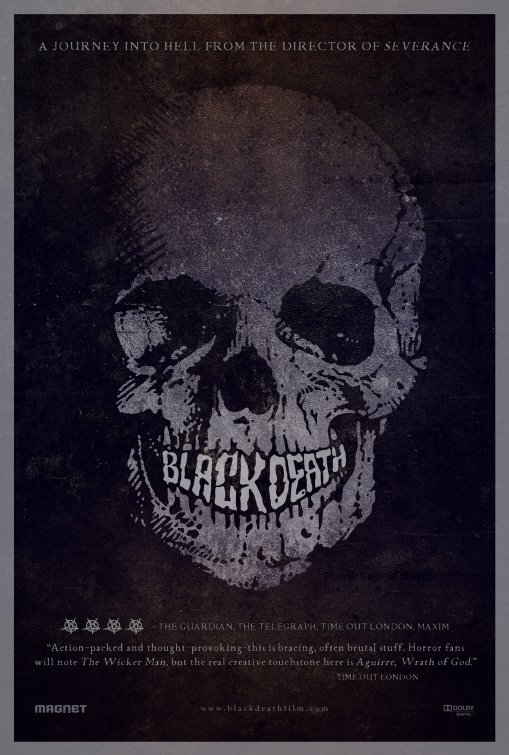
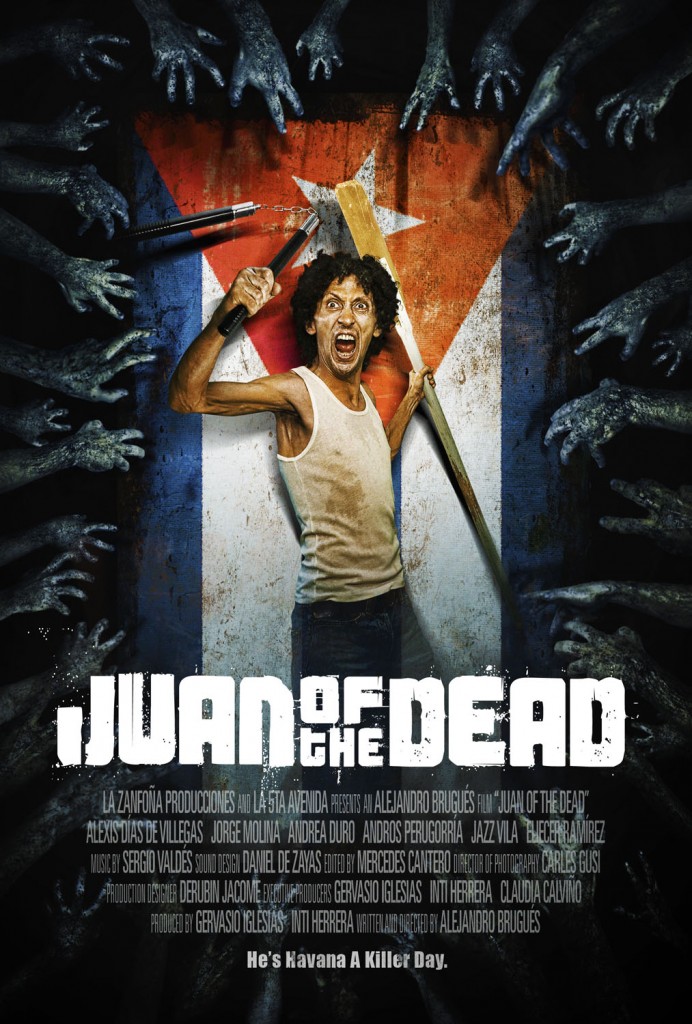
It’s very hard, at this point in time, to bring much to the zombie genre in terms of freshness and originality. AMC’s The Walking Dead brings the element of serialization to standard-issue zombie stories. WARM BODIES gave zombiedom and the living their own spin on Romeo & Juliet, whileWORLD WAR Z threw starpower at the genre. But let’s talk about is the delightful international contagion that is the zombie-comedy. The modern zombie film as we know it — small group of besieged survivors, extreme gore, varying degrees of social commentary — was established by the parameters of George A. Romero’s NIGHT OF THE LIVING DEAD. Though there were many zombie movies since, Romero perfected the art form in 1978’s DAWN OF THE DEAD. By the 1980s, the comedy versions began to arrive.
RETURN OF THE LIVING DEAD (1985). RE-ANIMATOR (1985). NIGHT OF THE CREEPS (1986). EVIL DEAD 2 (1987). DEAD HEAT (1988). BRAINDEAD a.k.a. DEAD ALIVE (1990). These are some of the films from what was probably the first cycle of zombie comedies. 1999’s IDLE HANDS was an overture, but the current cycle of zombie comedies probably began in full with 2003’s SHAUN OF THE DEAD. What I like best about SHAUN OF THE DEAD, which is a very, very English movie, is that it seems to have sparked a wave of other countries to offer up their own spin on the zombie comedy genre. New Zealand got back in the game with the very funny BLACK SHEEP (about zombie sheep, naturally). Norway came with DEAD SNOW. America took another rip with ZOMBIELAND, although America never really stopped with the zombie comedies. Japan has one called BIG TITS ZOMBIE (oh, Japan). This year, India released its first zombie comedy, called GO GOA GONE. Maybe my favorite of the current wave of international zombie comedies is 2011’s JUAN OF THE DEAD, a Spanish-Cuban co-production.
For sociopolitical reasons, Cuba has never been the most prolific national cinema. The state had a monopoly on Cuban film for many years. Independent film in Cuba is on the rise. This is one of many new films produced outside the state-financed Cuban Institute of Cinematic Art and Industry, made by younger filmmakers. Writer-director Alejandro Brugués is in his thirties. JUAN OF THE DEAD is exciting in part for its novelty — it’s Cuba’s first zombie movie — but more because the sense of culture and history informs the movie’s sensibilities. It would be an enjoyably rude film were it made anywhere, but it’s thrillingly rude because it came out of Cuba.
We first meet Juan (Alexis Díaz de Villegas) as he’s floating on a raft off the coast of Cuba. He and his best friend Lazaro (Jorge Molina) are looking, as always, for ways to make money. Instead, they encounter a floating corpse, in an orange convict’s jumpsuit. When the corpse raises its head to bite at them, Lazaro shoots it through the head with a harpoon gun. We, an audience with forty years of zombie movies behind us, know what’s happening right away, but Juan and Lazaro aren’t the kind of guys who watch movies like those, so they decide to keep this harpooning incident between them.
Right off the bat, there’s text and subtext going on — the subtext being that the first zombie we meet was a prisoner, probably not accidental symbolism. The text is that this is a different kind of slacker duo than we’ve seen in most movies of this time. Visually they are the classic skinny-tall man, squat-stout man combo, with Juan resembling John Turturro with the hairstyle of a Johnny Depp character and Lazaro resembling a porkier version of Chris Pontius from Jackass with the same fondness for exhibitionism, but otherwise they’re not as ingratiating as your typical Laurel & Hardy pair. These guys are schemers, thieves, adulterers, public onanists, and accidental murderers — and that’s just in the first ten minutes.
What’s interesting to me about this movie is that the protagonists are already desperate when the story opens. They live in a run-down building. They’re scrambling for money at all times. They both have adult children — Lazaro has a son named Vladi who often hangs around the guys, and Juan has a daughter, Camila, who can’t stand him — but otherwise no sense of responsibility outside the natural urges of eating and fucking. So when the zombie invasion erupts, it doesn’t make all that much of a difference to them. They are so unsentimental that Juan hardly bats an eye when the married woman whose window he climbed out of earlier is turned into a ravenous ghoul. In fact, for Juan and Lazaro the zombie invasion is more opportunity than anything else. Less living people to compete against, for one thing. Cause to open a new business, for another. “Juan Of The Dead. We kill your loved ones. How can we help you today?” Juan’s motley crew includes a transvestite named La China who is skilled with the slingshot and her apparent boyfriend, El Primo, a giant who faints easily and needs to be blindfolded in order to fight zombies. Eventually Camila convinces Juan to let her fight also. There’s an ironic democracy to the zombie-killing in this film, intentionally I think.
JUAN OF THE DEAD wouldn’t exist without the sum of its influences, but in many ways it surpasses them. There are plenty of familiar references: There’s a particular gesture towards the end that’s straight-up Bruce Campbell. Like DEAD ALIVE, there is a character who gets to say “I kick ass for the Lord!” — although that’s also the last thing he gets to say. In the tradition of SHAUN OF THE DEAD, there is a sort of impromptu dance scene, but instead of the lead characters dancing around a zombie like a maypole to a Queen song, here we have a man doing an inadvertent salsa in an attempt to get away from the gay zombie he’s handcuffed to. But there are divergences too. One notable aspect about JUAN OF THE DEAD is that, particularly compared to the relatively chaste films of Sam Raimi, Peter Jackson and Edgar Wright, it’s a downright horny film. There’s nudity all over the place. Sure, a lot of it is male nudity, but that’s even more of a departure. Sex and violence are the twin demons plaguing conservative minds everywhere, yet violence gets so much more screentime in most horror movies, which, in the end, do arguably have a duty to shock and offend. If that’s so, then JUAN OF THE DEAD gets the balance better than most.
That is the best description of JUAN OF THE DEAD — a concentrated burst of much-needed rudeness, a philosophical middle finger, a well-timed fart. These characters are unrepentant bastards. They’re callous and foolish, using words many of us wouldn’t use and doing things all of us had better not do. So much of good comedy is bad behavior, though, and that’s a handy signpost to keep in mind. Agreed, sometimes the energy and exuberance of the film gets away from its makers — the running time is relatively short yet it does have moments that are episodic and dead-ended, which divert from the momentum. It’s not a quote-unquote perfect film. But as the first volley of potentially a new national horror movement, it’s very encouraging. JUAN OF THE DEADrepresents the casually exposed ballsack of revolution.

THE BAY (2012)
A found-footage disaster film that’s just about the last thing you’d expect from the filmmaker behind DINER, THE BAY is fucking brutal. It gets under your skin and into your head, the way the most disturbing horror movies do. Kristen Connolly, co-star of the same year’s THE CABIN IN THE WOODS, is by far the most recognizable face in THE BAY, which is filled with a cast of excellent but so-far little-known actors. Don’t get too used to any of them in this movie, by the way. The story is unsparing, as it details gruesomely how bureaucratic negligence results in a horrific invasion of seaborne parasites that fairly well decimates a small Maryland town.
Thrillingly, veteran director Barry Levinson takes on the found-footage craze in horror, and schools every-damn-body on how to do it. Not only does THE BAY manage to stay honest and to circumvent all of the minor cheats of which most found-footage films are guilty, but he pushes the form to its maximum effectiveness, quite possibly creating a new genre in the process. THE BAY is an ecological horror film – it engages in legitimate science and convincing pseudo-science, in order to force an audience to consider some very real environmental questions. Unlike ghosts or aliens or Satan Himself, we can prove for a fact that cymothoa exigua exist. (Do not Google them if you’re eating.) They may not be any more of a threat to us than any fictionalized horror villain, but they sure do serve as an effective metaphor for things that are.
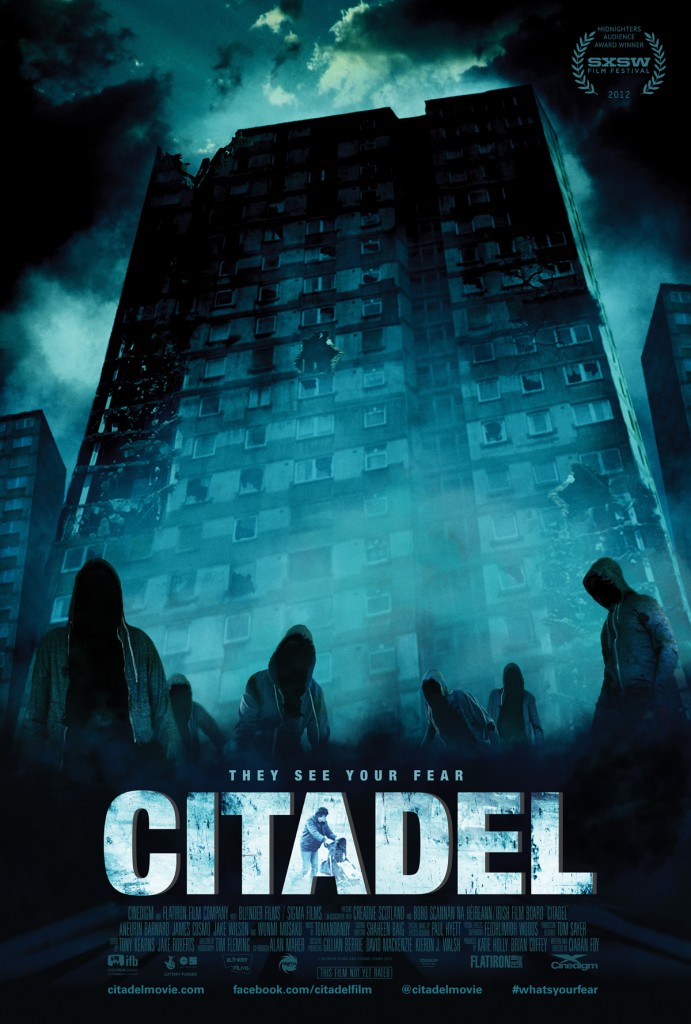
CITADEL (2012)
In the movie, a young man (Aneurin Barnard) and his very pregnant wife are assaulted by a gang of hooded figures in the apartment complex where they live. The wife doesn’t ultimately make it, although the baby does, and soon enough, out of constant panic the young man barricades himself and his infant child inside his apartment, leaving only under great duress, petrified that those malicious figures will return. Of course, they eventually do, and the question is, are they even human?
I like the intimate, personal, highly emotional feel of CITADEL, abetted as it is by warm and committed performances, evocative imagery, terrific use of atmospheric locations, and a sparse score. There are stretches where you can’t be sure the horror isn’t all in the protagonist’s mind, even as the worst is happening.
I really liked the supporting work of Wunmi Mosaku, as a sweet nurse who tries to help Tommy even though she isn’t fully able to believe him, and especially that of James Cosmo, best known to American audiences for his recent role in Game of Thrones and as Renton’s dad fromTRAINSPOTTING, as a belligerent priest fond of four-letter words who knows plenty about what those hooded characters are really about.
I’d describe CITADEL as the nightmare inversion of ATTACK THE BLOCK, or else as a UK update ofTHE BROOD, especially because both of those comparisons invite certain thematic preoccupations worth contemplating, but neither of those fully describe what makes CITADEL stand apart.
It’s the potent sense of conviction, so often lacking in modern horror, and so promising in the way of whatever project Ciarán Foy attempts to take on next. Most recently, that has been a very solid 2015 sequel to the 2012 horror film SINISTER, but after that, the sky’s the limit.
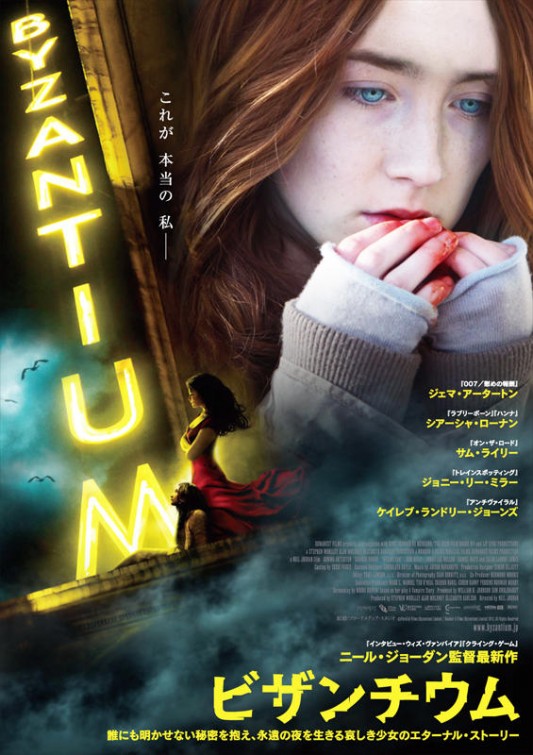
BYZANTIUM (2013)
I’m honestly not normally the hugest fan of Neil Jordan, who is most famous in horror circles forTHE COMPANY OF WOLVES and INTERVIEW WITH THE VAMPIRE. He makes sumptuous, swirling gothic, romantic pieces which are arguably more highbrow than the kind of horror flicks I love best — don’t get your costume drama in my monster movie. But I liked what I read about the femme-centric approach by screenwriter Moira Buffini, about an immortal mother-daughter pair of vampires; one who works as a prostitute or a stripper or whatever trade she can to keep money coming in and to provide her with dudes scummy enough to use as lunchmeat, and the other a perpetual teenager with a conscience, who only kills willing victims, liberating the infirm from their mortal shells. Saoirse Ronan is typically effective and soulful in this part, making delicate moments seem natural, an uneasy task for a young performer but we’re almost used to it at this point. It’s Gemma Arterton who is a fearsome revelation.
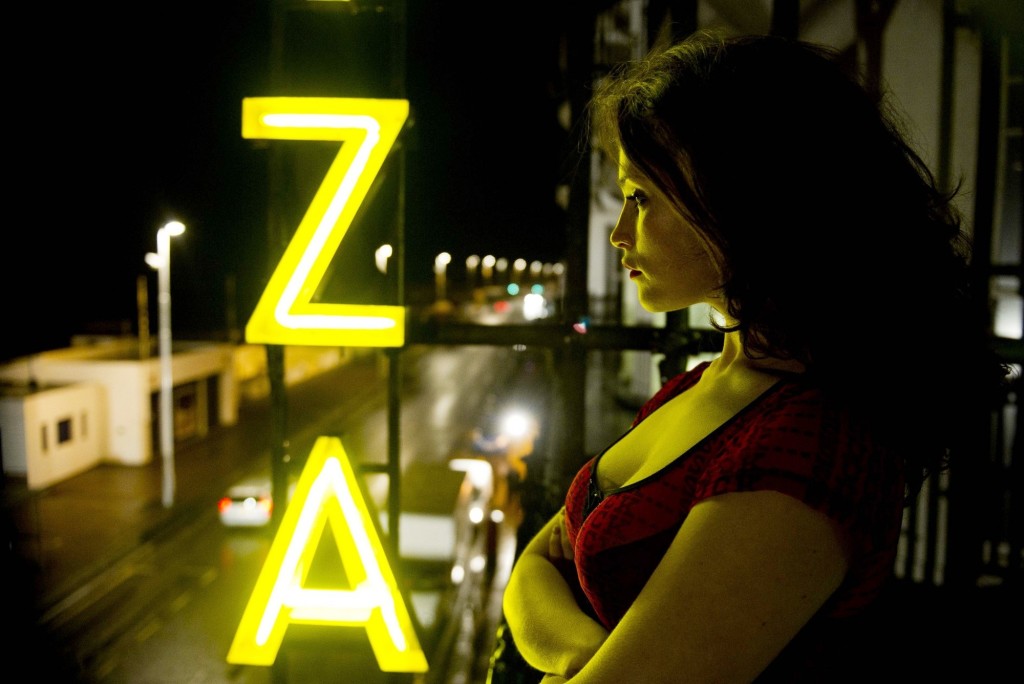
If you’ve seen Stephen Frears’ TAMARA DREWE you know she can blow up the screen with unrestrained sensuality, but here she makes it scary. In this movie, she’s a monster made of sex. Check out that still frame above. She may be a right fine figure of a woman, but the bottom line is she’s gonna tear your head off, dude. It’s great. The other star of BYZANTIUM is cinematographer Sean Bobbitt, who had an epic 2013 (he shot 12 YEARS A SLAVE, amidst three other features) — I’ve seen thousands of movies in my day, so I can honestly tell you that no one has ever filmed a waterfall made of blood as beautifully as this man has.
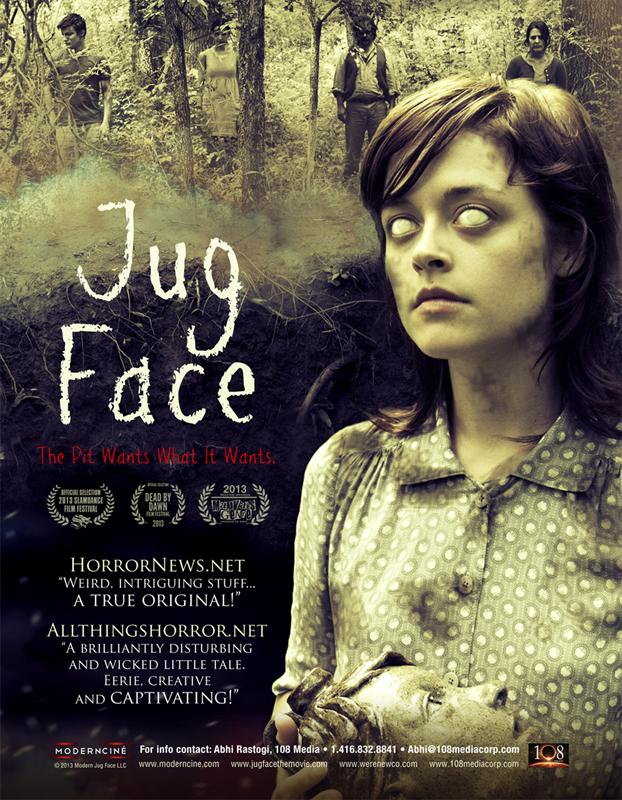
JUG FACE (2013)
Most horror films are content to be intermittently scary. One of the most original motion pictures of the year, JUG FACE is more eerie and unsettling, on a long sustained note. Horror films have a long history of short-shrifting backwoods folk, making them out to be wild-eyed maniacs. JUG FACEdetails an unusual community who live just outside of the America you and I know. The villagers have their own customs and beliefs. Sean Bridgers, star of the often-overlooked THE WOMAN, plays a kind of savant who fashions creepy-looking jugs out of clay from the earth. The jugs have faces on them. Community tradition holds that when your face comes up on the jug, it’s your turn to be sacrificed to the pit which the assembled populace worships. The villagers have a generally fatalistic attitude towards this ceremony. When it’s time, it’s time. But the independent-minded Ada (Lauren Ashley Carter) hides her jug when it comes up, which wreaks all kind of unforeseen havoc. In a world where marriages are arranged, Ada wants to love who she loves. The thing is, the first time we meet Ada, she’s having sex in the woods with her own brother. And this is our point-of-view character! Amazingly, Ada remains sympathetic throughout, in part because she’s the only one questioning anything, or thinking of anyone other than herself. Sean Young and Larry Fessenden play her parents, one a grotesque and bellowing matriarch, the other a true company man, which is bad news in this case. Lauren Ashley Carter has an open expressive face that draws your sympathies, even if you have to wonder what future Ada can have, even if she does manage to escape her fate. This is an odd, challenging movie, but there aren’t two like it. I have no earthly idea what writer/director Chad Crawford Kinkle will do next, but I do know I will be checking it out.
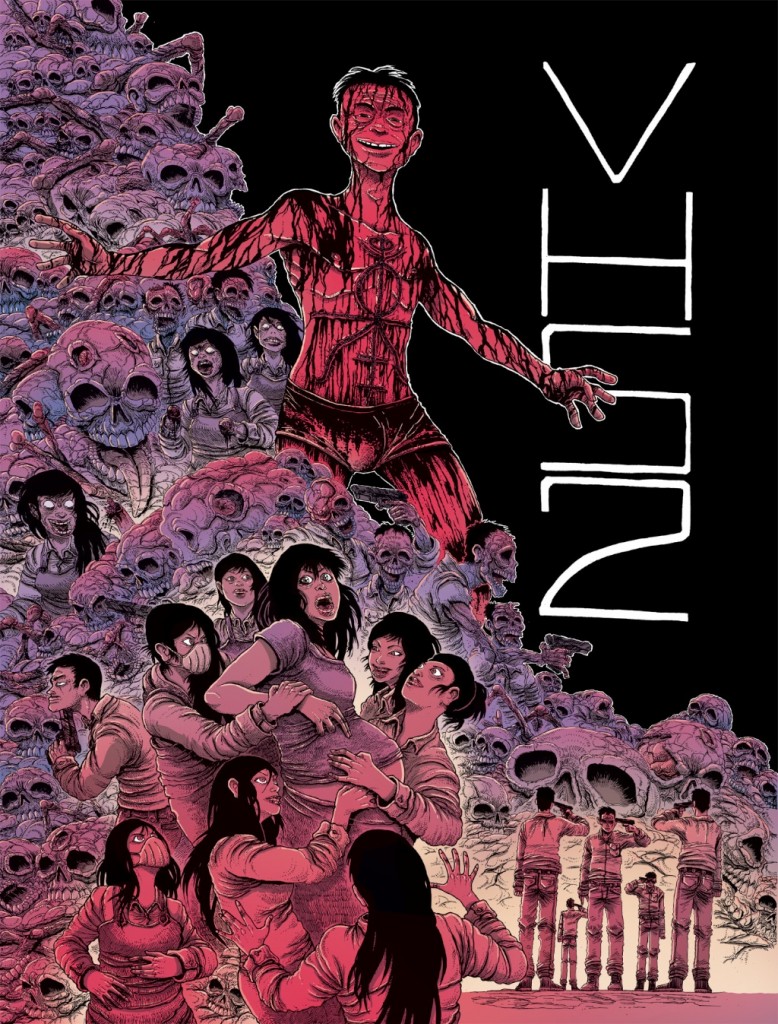
V/H/S II: “Safe Haven” (2013)
V/H/S II is the second installment of the horror anthology that brings together some of the coolest and most promising new horror directors around for found-footage mayhem. There are many more bad found-footage movies than good, but this is the good stuff. Now, V/H/S II is a solid amalgamation of frights, but there is one segment that stands out. It’s called SAFE HAVEN. There’s good stuff to the left of it and great stuff to the right — the Jason Eisener segment, SLUMBER PARTY ALIEN ABDUCTION, is like candy, it’s so tend-ah — but SAFE HAVEN is on a whole different stratosphere, like on the moons of Jupiter or something. A collaboration between Timo Tjahjanto and Gareth Huw Evans (director of THE RAID) and set and shot in Indonesia, this story begins with a news crew doing an investigative report into an eerie cult, which soon enough erupts in violence and mass suicide. And then things get really crazy. SAFE HAVEN is freaky, fucked up, out of control and just a little bit hilarious. It’s a let’s-watch-that-again-right-away kind of wildness. It’s not much more than a quarter of an hour, but it’s one of the most exhilarating chunks of horror filmmaking of the decade, in my opinion, and solid proof Gareth Evans, at a scarily young age already a master director of action, needs to make a horror feature on the double.

AT THE DEVIL’S DOOR (2014)
As far as those rare films that actually have moments capable of freaking a hardy veteran horror viewer like me out, AT THE DEVIL’S DOOR would have to be one of the best of the past few years. I really liked Nicholas McCarthy’s last movie, THE PACT, and I think I liked this newer one even better. This is a filmmaker who knows how to get the maximum mood out of minimal spaces. He’s also got an interesting eye for casting. At this point any movie, regardless of genre, with not one but three female protagonists — two of them non-white — has to earn points off that alone, but this is a genuinely effective scary movie on its own merit, scary because it manages to make you care for these women and want to see them succeed.
The three lead performances are strong — the film’s unconventional structure means we spend more time with some than others, but all of them are sketched in with just enough detail and emotional momentum that they feel like people we could know and care about. To me, that’s the key to effective horror. Scary monsters don’t mean shit without sentiment and attachment to those being menaced. In that regard, AT THE DEVIL’S DOOR has an emotional bazooka in its arsenal, the luminous Catalina Sandino Moreno, an under-utilized actress who the camera adores. Without spoiling any plot points, it’s her strong presence in the movie’s middle passages that holds the whole thing together, and quietly powers the very effective final act. AT THE DEVIL’S DOOR is modest, quiet, and somewhat understated, but it worked for me.
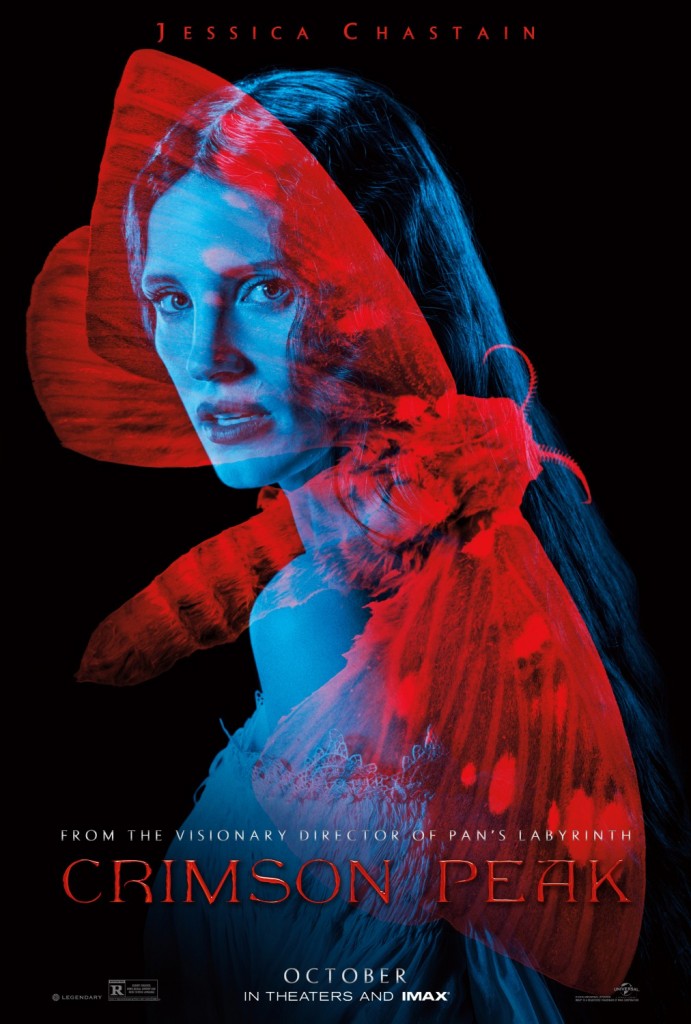
CRIMSON PEAK (2015)
The newest addition to any list of under-heralded horror movies, CRIMSON PEAK earns its place here simply because it’s not too late — you can still get out there to support it while it’s in theaters, as long as you act fast. See it on the biggest screen you can. Let it enfold you. It’s a film to be absorbed. CRIMSON PEAK cost a lot of money and it looks like it. Hate to say I understand why it’s underperforming in America — with whispers of incest and baby murders, less sophisticated audiences can easily miss the point. Not that those elements are meant to be a draw — quite the contrary, but it’s admirable that a film engaging with the notion of fear betrays little itself. This movie is brave and bold. And subject matter aside, it’s a legitimate marvel of production design and costuming. Director Guillermo Del Toro and his cinematographer Dan Laustsen maximize the frame, infusing every millimeter with rich color and deep shadow. The movie blooms. Of the performers in the film, Jessica Chastain dominates — her role is recessive by design for the first two-thirds of the story, but when she takes center stage, it’s with redoubtable ferocity. Del Toro has said the film isn’t intended as a horror movie — if that’s the case, put Chastain down for all the awards, since horror never gets its due. But if it is a horror movie, then she’s its most fearsome monster, and good God is that a beautiful thing.
– JON ZILLA.
- [THE BIG QUESTION] WHAT’S YOUR FAVORITE FEMALE ENSEMBLE IN MOVIES? - July 22, 2016
- [IN THEATERS NOW] THE BOY (2016) - January 24, 2016
- Cult Movie Mania Releases Lucio Fulci Limited Edition VHS Sets - January 5, 2016
Tags: Answer Tracks, Horror, Lists

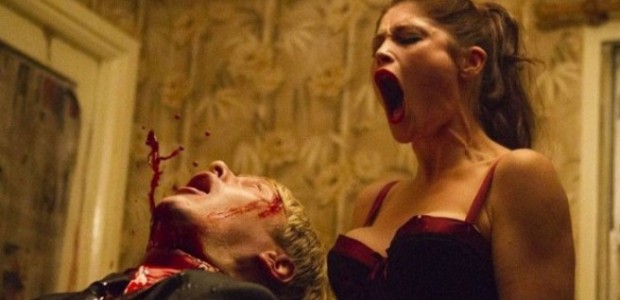
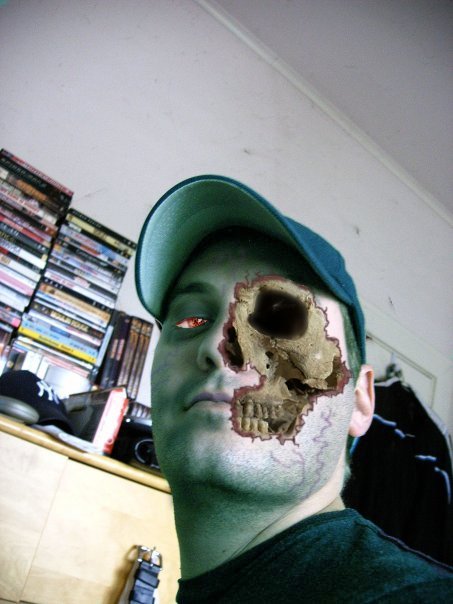




No Comments